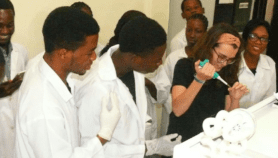Send to a friend
The details you provide on this page will not be used to send unsolicited email, and will not be sold to a 3rd party. See privacy policy.
Are South Africa’s science policy choices hindering its drive to commercialise research and speed development? Sonja van Renssen reports.
Emile van Zyl, a professor of microbiology at South Africa’s University of Stellenbosch, once heard an analogy that he thinks says a lot about science policy in his country.
"Japan will come up with an idea and then decide who’s going to do it," he says. "Then they ask the team what they will need. Finally, they decide where they are going to do it, and they build the building. In South Africa, we build the building and then ask what are we going to do with it?"
This tendency to let enthusiasm override rational, long-term planning has increasingly affected science policy since apartheid ended in 1994 and South Africa launched ambitious plans to use science to drive economic growth.
Guided by international experts, South Africa became the first developing country to adopt a ‘national innovation system’, focusing on building interactions between government, industry and universities rather than developing each sector independently (see ‘The ‘system of innovation’ approach, and its relevance to developing countries’).
Just over a decade later, policy experts say it is too early to judge whether this approach will deliver economic growth and a better quality of life; but some stakeholders are now voicing concerns over policies in areas such as the commercialisation of local research.
In 1994, policymakers believed South Africa had a sufficiently strong scientific infrastructure and human resource base to start building a modern, Western-style knowledge economy. They felt that a drive to commercialise local research was key to this, whether through universities licensing intellectual property to existing businesses, setting up ‘spin-out’ companies, or collaborating with industry.
The policymakers had seen such forms of technology transfer give birth to major industries such as biotechnology in the industrialised world. But the enthusiasm for results, according to some stakeholders, has not always led to prudent policies.
Short-term temptations
One problem, say critics, is the Innovation Fund — the government’s key mechanism for promoting technology transfer. Set up as part of in1996, the fund’s aim is to help transfer promising technologies into the marketplace by backing projects with commercial potential at the ‘proof-of-concept’ stage.
The fund’s former chairperson Adi Paterson accepts, however, that in the past two years it has increasingly invested in projects much further down the research and development pipeline. This has generated accusations of a government playing, rather than shaping, the market.
"They are trying to be venture capitalists, to invest in technology that will give them a direct return," says one South African university research manager, who asked not to be named.
He questions the ethics of a government investing public money as venture capital — and whether it has the expertise to do this in the first place: "They don’t seem to understand that return will come to them through the tax system."
As a result of the fund’s shifting focus, South Africa’s gleaming new incubator facilities – like the Biotechnology Regional Innovation Centres (known as BRICs) — have struggled to find tenants.
Investment in early research is necessary to ensure future opportunities for commercialisation, says van Zyl. "There are some ripe cherries, but who’s going to create the next generation of ripe cherries?" he asks "We’re not investing in future research, we’re just picking what’s ready to pick now."
The right to intellectual property
But as technology transfer experts attest, commercialisation also demands a strong enabling environment to transform ideas into business opportunities. South Africa lacks a culture of entrepreneurship, an interest from big companies to support smaller ones, and a venture capital sector willing to take risks.
And on a more fundamental level, the country has yet to pass national legislation on intellectual property (IP) rights.
To commercialise its research, a university must have IP rights over it. The 1980 Bayh-Dole Act gave US universities such rights over any research they did, regardless of who funded it, and is often credited with kick-starting the subsequent technology transfer boom in the United States.
But in South Africa, while some universities have their own IP policies, most do not.
Jacques Stofberg, financial manager of the University of Stellenbosch’s technology transfer team, says a national IP policy would establish a platform for innovation across the country and streamline existing policies to simplify the work of bodies such as the Innovation Fund.
Such a policy could prevent industry from negotiating sole ownership rights over research it has contributed little funding to, and could also enable the government to negotiate access to inventions for the public good, such as new HIV/AIDS drugs.
Given its importance, why does a national IP policy remain elusive? Stofberg points out that some 70 per cent of research in South Africa is funded by industry, not government, rendering an act like Bayh-Dole inappropriate.
A possible alternative model is Germany’s Berlin Contract, through which each party’s right to the fruits of research are determined by their input.
Experience suggests that responsibility for creating an enabling environment rests also with universities. Studies point to the need for a culture of entrepreneurship backed by strong management and an institutional set up that encourages innovative research and provides both incentives and opportunities for academics to commercialise their work.
Stellenbosch — which won the award for most innovative university in South Africa last year — with its small but growing technology transfer office and generous IP policy is a good example of what can be achieved.
Building supply and demand
Technology transfer studies have shown that the number of innovations arising from research is directly proportional to the amount of funding. Van Zyl feels that in its drive to build human resources, the South African government is again letting enthusiasm for a particular cause cloud the bigger picture.
Van Zyl and other scientists cite a serious lack of funding for equipment and materials over the past few years. They say universities have the resources to take on postgraduate students, but not the money to give them any research to do. As a result, South Africa’s research capacity is compromised, and promising students are leaving the country. "We are doing capacity building for the outside world," van Zyl says.
And problems on the supply side are matched by weak demand from business. The government’s most recent science policy paper — the 2002 National R&D Strategy — warns that economic growth arising from local research remains limited.
Major South African companies such as the large chemicals and energy corporation Sasol have traditionally done much research in-house, which means little ‘pulling’ of ideas out of universities into the machinery of commercialisation.
Studies suggest that to change this, South Africa must produce world-class research, and provide opportunities for close collaboration, and incentives to encourage companies to increase their expenditure on research and development. While the latter is high for a developing country, at 55 per cent of total spent each year, the net amount is declining.
A growing number of African countries are recognising that science and technology can make key contributions to development (see Will 2006 rise to the challenges laid down by 2005?). Despite South Africa’s distinctive history, culture and socio-economic status, nations such as Nigeria that are currently integrating national innovation systems into their development frameworks could take valuable lessons from the South African experience of research commercialisation.













